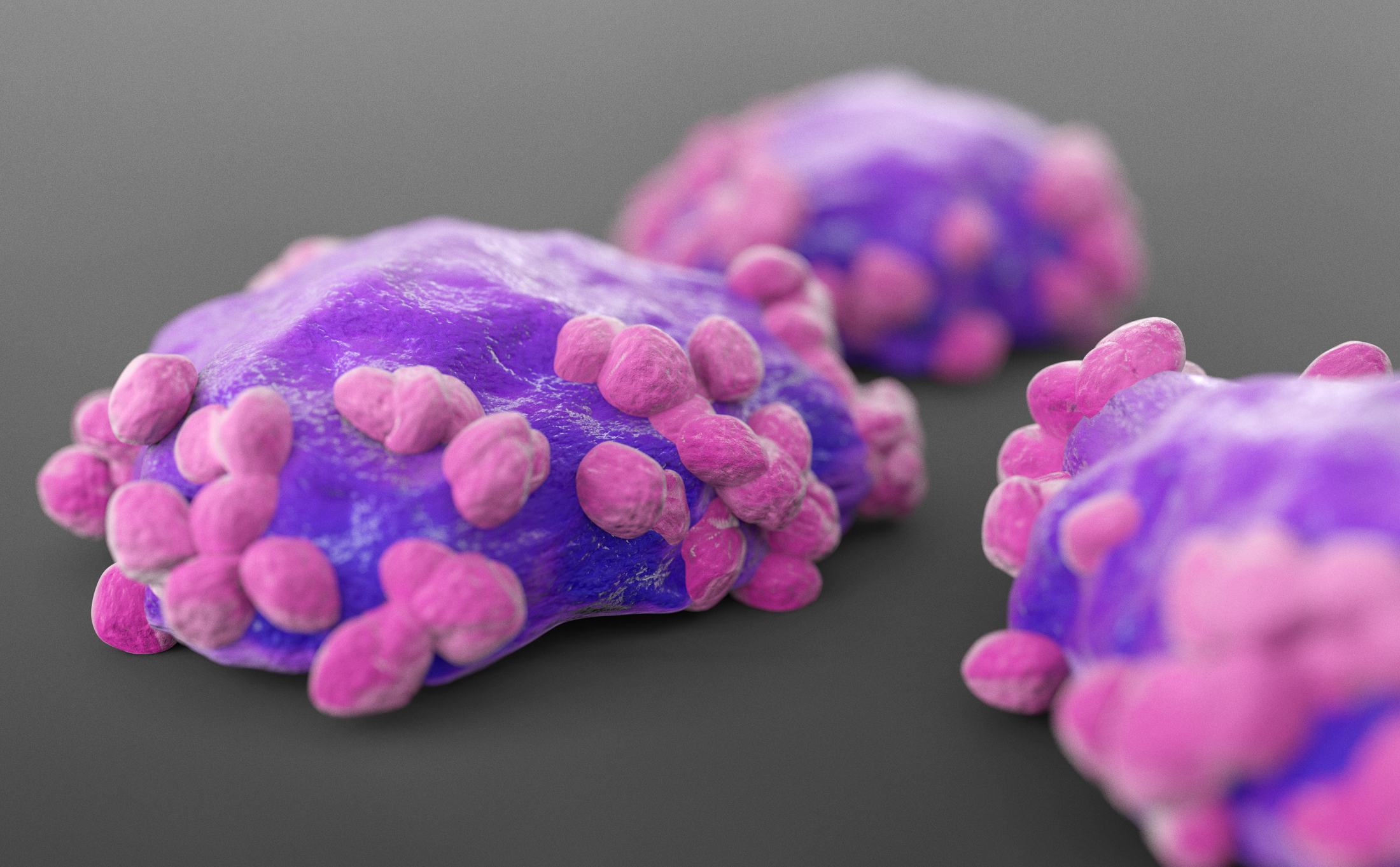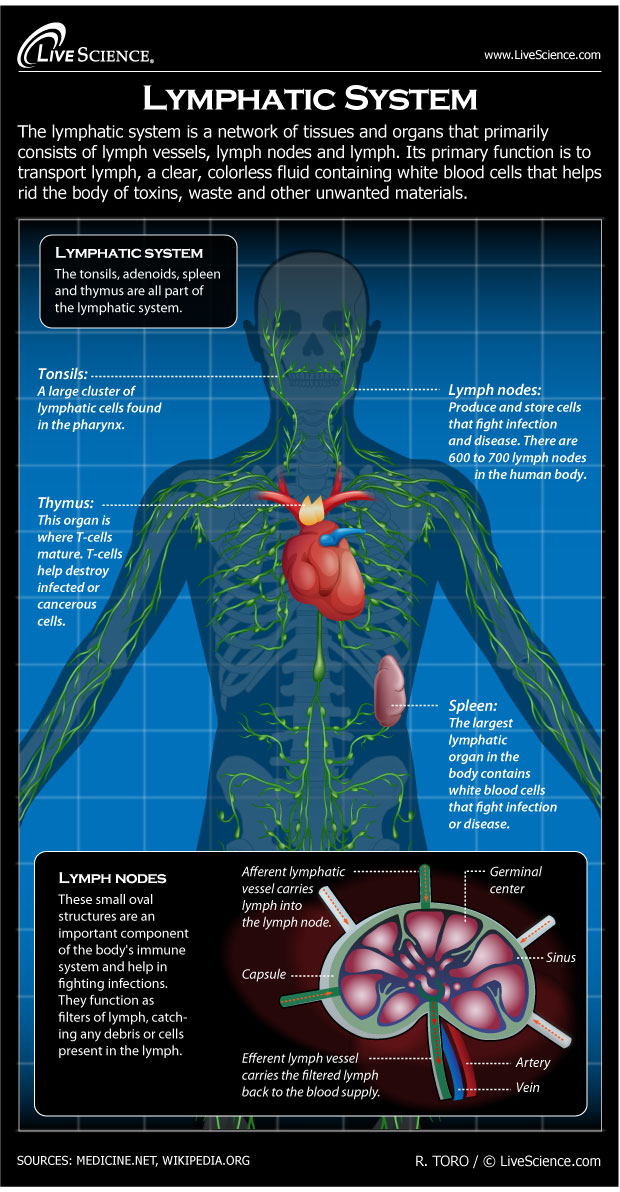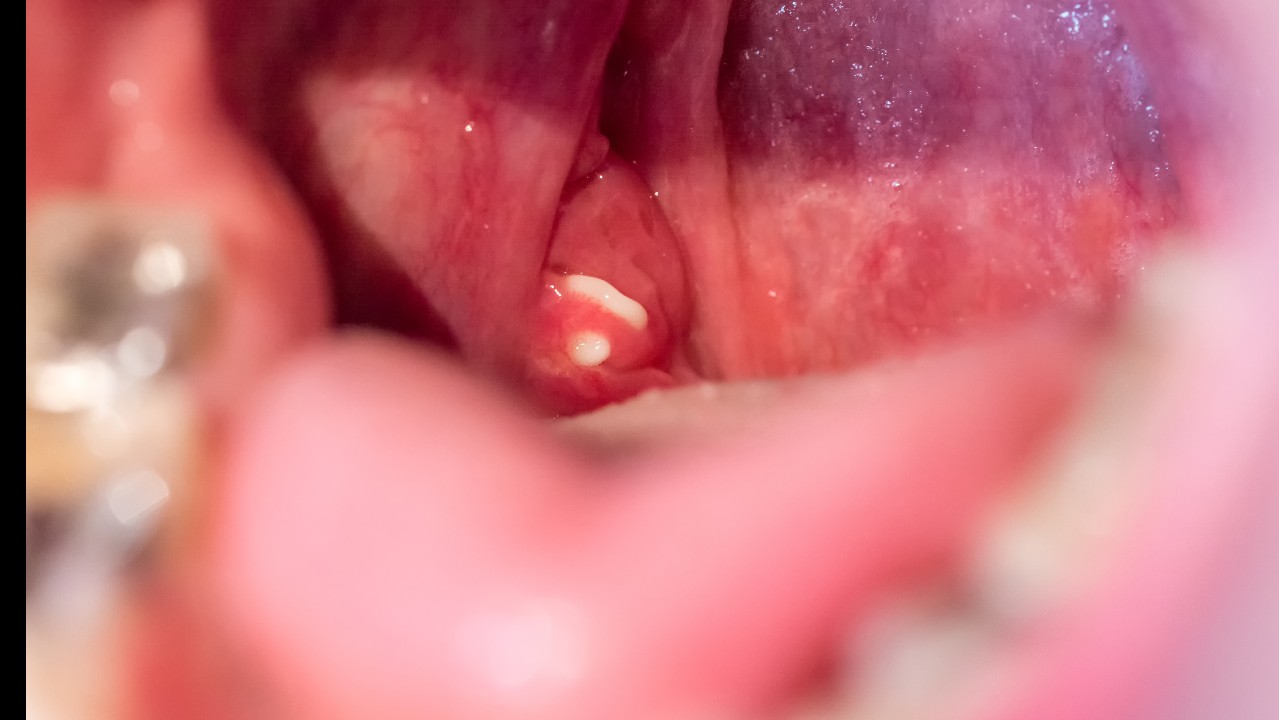The lymphatic system: Facts, functions & diseases
How the lymphatic system gets rid of body toxins and fuels your immune system

The lymphatic system is a network of tissues and organs that help rid the body of toxins, waste and other unwanted materials. The primary function of the lymphatic system is to transport lymph, a fluid containing infection-fighting white blood cells, throughout the body, according to the journal Lymphatic Research Biology.
The lymphatic system primarily consists of lymphatic vessels, which are similar to the veins and capillaries of the circulatory system. The vessels are connected to lymph nodes, where the lymph is filtered. The tonsils, adenoids, spleen and thymus are all part of the lymphatic system.
- Related: How to improve your circulation
Description of the lymphatic system
There are hundreds of lymph nodes in the human body. They are located deep inside the body, such as around the lungs and heart, or closer to the surface, such as under the arm or groin, according to the American Cancer Society. The lymph nodes are found from the head to around the knee area.
The spleen, which is located on the left side of the body just above the kidney, is the largest lymphatic organ, according to the U.S. National Library of Medicine (NLM). "The spleen . . . acts as a blood filter; it controls the amount of red blood cells and blood storage in the body, and helps to fight infection," said Jordan Knowlton, an advanced registered nurse practitioner at the University of Florida Health Shands Hospital.
If the spleen detects potentially dangerous bacteria, viruses, or other microorganisms in the blood, it — along with the lymph nodes — creates white blood cells called lymphocytes, which act as defenders against invaders. The lymphocytes produce antibodies to kill the foreign microorganisms and stop infections from spreading. Humans can live without a spleen, although people who have lost their spleen to disease or injury are more prone to infections.
The thymus is located in the chest just above the heart, according to Merck Manual. This small organ stores immature lymphocytes (specialized white blood cells) and prepares them to become active T cells, which help destroy infected or cancerous cells.
Tonsils are large clusters of lymphatic cells found in the pharynx. According to the American Academy of Otolaryngology, they are the body's "first line of defense as part of the immune system. They sample bacteria and viruses that enter the body through the mouth or nose." They sometimes become infected, and although tonsillectomies occur much less frequently today than they did in the 1950s, it is still among the most common operations performed and typically follows frequent throat infections.
Lymph is a clear and colorless fluid; the word "lymph" comes from the Latin word lympha, which means "connected to water," according to the National Lymphadema Network.
Plasma leaves the body's cells once it has delivered its nutrients and removed debris. Most of this fluid returns to the venous circulation through tiny blood vessels called venules and continues as venous blood. The remainder becomes lymph, according to the National Cancer Institute.
Unlike blood, which flows throughout the body in a continuous loop, lymph flows in only one direction — upward toward the neck. Lymphatic vessels connect to two subclavian veins, which are located on either sides of the neck near the collarbones, and the fluid re-enters the circulatory system, according to the National Cancer Institute.
Diseases and disorders
Diseases and disorders of the lymphatic system are typically treated by immunologists. Vascular surgeons, dermatologists, oncologists and physiatrists also get involved in treatment of various lymphatic ailments. There are also lymphedema therapists who specialize in the manual drainage of the lymphatic system.
The most common diseases of the lymphatic system are enlargement of the lymph nodes (also known as lymphadenopathy), swelling due to lymph node blockage (also known as lymphedema) and cancers involving the lymphatic system, according to Dr. James Hamrick, chief of medical oncology and hematology at Kaiser Permanente in Atlanta.
When bacteria are recognized in the lymph fluid, the lymph nodes make more infection-fighting white blood cells, which can cause swelling. The swollen nodes can sometimes be felt in the neck, underarms and groin, according to the NLM.
Lymphadenopathy is usually caused by infection, inflammation, or cancer. Infections that cause lymphadenopathy include bacterial infections such as strep throat, locally infected skin wounds, or viral infections such as mononucleosis or HIV infection, Hamrick stated. "The enlargement of the lymph nodes may be localized to the area of infection, as in strep throat, or more generalized as in HIV infection. In some areas of the body the enlarged lymph nodes are palpable, while others are to deep to feel and can be seen on CT scan or MRI."
Inflammatory or autoimmune conditions occur when a person's immune system is active, and can result in enlargement of lymph nodes. This can happen in lupus, according to Hamrick.
Lymphoma:
This refers to cancer of the lymph nodes. It occurs when lymphocytes grow and multiply uncontrollably. There are a number of different types of lymphoma, according to Dr. Jeffrey P. Sharman, director of research at Willamette Valley Cancer Institute and medical director of hematology research for the U.S. Oncology Network.
"The first 'branch point' is the difference between Hodgkin lymphoma and non-Hodgkin lymphoma (NHL)," Sharman said. Non-Hodgkin lymphoma is one of the most common cancers in the United States, according to the American Cancer Society. It’s estimated that around 80,000 people in the US will be diagnosed with the NFL in 2022.

The most common types of NHL are follicular, which accounts for about 30% of all NHL cases; diffuse large B-cell lymphoma (DLBCL), which comprises 40 to 50% of NHL cases; and Burkitt's lymphoma, which accounts for 5% of NHL cases, according to the Lymphoma Research Foundation. "The remainder of cases makes up the bewildering complexity of NHL," Sharman said.
"Though there can be a significant range within an individual category, the clinical approach to each category is unique and the expectations of patient outcome varies by category," Sharman said.
When a person has had surgery and/or radiation to remove a cancer, the lymphatic flow back to the heart and can result in swelling or lymphedema, Hamrick noted. This most commonly occurs in women who have had surgery to remove a breast cancer. Part of the operation to remove the breast cancer involves removing lymph nodes in the armpit.
The more lymph nodes removed the higher the risk of chronic bothersome swelling and pain due to lymphedema in the arm, Hamrick explained. "Fortunately, modern surgical techniques are allowing for fewer lymph nodes to be removed, and thus fewer cases of severe lymphedema for breast cancer survivors."
Some interesting research has been done on why people possibly get lymphoma. For example, VU University Medical Center in Amsterdam researched a nationwide Dutch pathology registry between 1990 and 2016. From the research, they estimated that the risk of developing anaplastic large cell lymphoma in the breast after getting implants is 1 in 35,000 at age 50, 1 in 12,000 at age 70, and 1 in 7,000 at age 75. The study was published in the Jan. 4, 2018 issue of the journal JAMA Oncology.
Diagram of the lymphatic system

Castleman disease:
This disease refers to a group of inflammatory disorders that cause lymph node enlargement and can result in multiple-organ dysfunction, according to the Castleman Disease Cooperative Network. While not specifically a cancer, it is a similar to a lymphoma and is often treated with chemotherapy. It can be unicentric (one lymph node) or multicentric, involving multiple lymph nodes.
Lymphangiomatosis:
This disease involves multiple cysts or lesions formed from lymphatic vessels, according to the Lymphangiomatosis & Gorham's Disease Alliance. It is thought to be the result of a genetic mutation.
Lymphatic filariasis:
Considered a neglected tropical disease (NTD), this parasitic disease is caused by the infiltration of a thread-like worm that infects the lymphatic system, according to the Centers for Disease Control and Prevention (CDC). Most cases worldwide of lymphatic filariasis are caused by a parasite called Wuchereria bancrofti. Millions of these microscopic worms can enter a person’s bloodstream through mosquito bites, before travelling to a lymph node where they will grow and reproduce. The majority of cases of lymphatic filariasis are asymptomatic and show no external signs of the disease, according to the World Health Organisation (WHO). In chronic cases, it can cause lymphoedema and skin and tissue thickening called elephantiasis. A blood test is required to diagnose the disease. “People living for a long time in tropical or sub-tropical areas where the disease is common are at the greatest risk for infection. Short-term tourists have a very low risk,” according to the CDC’s FAQ page on Lymphatic filariasis.
Tonsilloliths:
Tonsil stones are another problem that can happen to the lymphatic system. Small bits of debris catch on the tonsils and white blood cells attack the debris and leave behind a hard biofilm that breathes oxygen. They are not smooth like regular stones, though. "Instead, they look like prunes, with crevices where bacteria can accumulate," said Chetan Kaher, a dentist in London. Usually, tonsil stones fall away and get swallowed, but sometimes they need to be manually removed.

Diagnosis and treatment
Diseases of the lymphatic system are usually diagnosed when lymph nodes are enlarged, Hamrick noted. This may be discovered when the lymph nodes become enlarged enough to be felt ("palpable lymphadenopathy") or are seen on imaging studies such as CT scans or MRIs.
The majority of enlarged lymph nodes are not dangerous; they are the body's way of fighting off an infection, such as a viral upper respiratory infection. If the lymph nodes become significantly enlarged and persist longer than the infection, then they are more worrisome. There is no specific size cutoff, but typically nodes that persist at larger than a centimeter are more worrisome and warrant examination by a doctor.
Common symptoms of any lymphatic disorder include swelling of the arm or groin, weight loss, fever and night sweats, according to Stephanie Bernik, chief of surgical oncology at Lenox Hill Hospital in New York. "A PET or CAT scan is usually ordered to further investigate."
The diagnosis of lymphadenopathy depends on the location of the abnormal lymph nodes and other things that are going on with the patient. If the patient has a known infection, then the lymph nodes can simply be followed to await resolution with treatment of the infection. If the nodes are growing quickly and there is no obvious explanation then typically a biopsy is warranted to look for a cancer or an infection. If the node can be felt then this can be done at the bedside with a needle, according to Hamrick.
If the lymph node is deeper, such as in the abdomen or pelvis, Hamrick said the biopsy might need to be done by an interventional radiologist using image guidance to place the needle into the node. Sometimes the biopsy needs to be done by a surgeon in the operating room. This is often where the most tissue can be obtained to make a diagnosis, he said.
With many types of lymphoma and leukemia, there are unique treatment options for each type, according to Sharman. "There is no one 'summary' of treatment options. Treatment options can include traditional chemotherapy, immunotherapy (such as using antibodies or immune modulating drugs), and even radiation."
Treatment of lymphatic diseases depends on treating the underlying cause. Infections are treated with antibiotics, supportive care (while the immune system does its job, as in a viral infection) or antivirals. Lymphedema can be treated by elevation, compression and physical therapy. Cancers of the lymphatic system are treated by chemotherapy, radiotherapy, surgery, or a combination of those modalities, Hamrick noted.
In last several years, Sharman noted that there has been explosion of new treatment options. "There are a handful of newly approved drugs that target the actual disease causing processes within cells. Ibrutinib, idelalisib, obinutuzumab, lenalidomide have been approved in various indications and it is likely that we will see multiple more in coming years.
Additional resources
If you're looking for more information about lymphoma visit the charity Lymphoma Out Loud or The Sidney Kimmel Comprehensive Cancer Center. For a deeper dive into the body's immune system check out "Immune: A Journey into the Mysterious System That Keeps You Alive" by Philipp Dettmer.
Bibliography
- Melody Swartz, "The physiology of the lymphatic system," Advanced Drug Delivery Reviews, Volume 50, August 2001, https://doi.org/10.1016/S0169-409X(01)00150-8
- Hiroo Suami & Mario F. Scaglioni, "Anatomy of the Lymphatic System and the Lymphosome Concept with Reference to Lymphedema," sEMINARS IN pLASTIC sURGERY, vOLUME 32, 2018, https://doi.org/10.1055/s-0038-1635118
- Antonino Carbone et al, "Follicular lymphoma," Nature Reviews Disease Primers, Volume 5, December 2019, https://doi.org/10.1038/s41572-019-0132-x
- Naritee Sukswai et al, "Diffuse large B-cell lymphoma variants: an update," Pathology, Volume 52, January 2020, https://doi.org/10.1016/j.pathol.2019.08.013
- Guillermo Oliver et al, "The Lymphatic Vasculature in the 21st Century: Novel Functional Roles in Homeostasis and Disease," Cell, Volume 182, July 2020, https://doi.org/10.1016/j.cell.2020.06.039
Sign up for the Live Science daily newsletter now
Get the world’s most fascinating discoveries delivered straight to your inbox.
Kim Ann Zimmermann is a contributor to Live Science and sister site Space.com, writing mainly evergreen reference articles that provide background on myriad scientific topics, from astronauts to climate, and from culture to medicine. Her work can also be found in Business News Daily and KM World. She holds a bachelor’s degree in communications from Glassboro State College (now known as Rowan University) in New Jersey.










